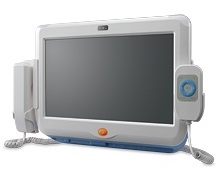Dual-core panel PC’s for hospital patients
Apr 27, 2011 — by LinuxDevices Staff — from the LinuxDevices Archive — 1 viewsAdvantech announced an “infotainment terminal” for hospital patients that includes a 15.6-inch touchscreen and a single- or dual-core Intel Atom processor. The PIT-1502W offers a resistive touchscreen with 1366 x 768 pixel resolution, a two megapixel camera, Wi-Fi, RFID, and a smart card reader, according to the company.
Advantech first released a PC designed especially for hospital patients in 2009: Its PIT-1702 had a 17-inch touchscreen display, a front panel that met IP65 standards for resistance to liquids and dust, and a choice of 1.6GHz Celeron or Core 2 Duo CPUs. A 2010 followup known as the PIT-1501W had similar attributes, but with a 15.6-inch display and a 1.6GHz Atom Z530 processor.
 The new PIT-1502W (right) is a refresh that switches to Intel's ICH8M chipset and a choice of either the single-core Atom D410 or dual-core Atom D510. Still offering a 15.6-inch resistive touchscreen with a resolution of 1366 x 768 pixels, the device gets an improved contrast ratio (300:1), and the available webcam now offers two megapixels instead of 1.3, according to Advantech.
The new PIT-1502W (right) is a refresh that switches to Intel's ICH8M chipset and a choice of either the single-core Atom D410 or dual-core Atom D510. Still offering a 15.6-inch resistive touchscreen with a resolution of 1366 x 768 pixels, the device gets an improved contrast ratio (300:1), and the available webcam now offers two megapixels instead of 1.3, according to Advantech.
Advantech suggests that patients can entertain themselves via the device's optional TV tuner, get updates on their condition via a hospital's intranet, or keep in touch with relatives via the Internet. Offered with an optional wired remote controller and handset, the PIT-1502W is suitable for VoIP phone calling, the company adds.
Other hospital-specific features for the panel PC, apart from its white-and-blue color scheme, are said to include a nurse call button and an LED indicator that goes with it. The PIT-1502W features a standard smart card reader, plus optional bar code scanning and RFID capabilities, says Advantech.
According to Advantech, the PIT-1502W accepts up to 2GB of RAM, while fixed storage is provided via either CompactFlash or an optional SATA hard disk drive. A Mini PCI Express slot accepts an optional 802.11b/g/n wireless LAN adapter, the company adds.
Wired connectivity on the PIT-1502W includes three USB 2.0 ports, a gigabit Ethernet port, a microphone input, a line output, and an isolated serial port, Advantech says. The PC also includes stereo speakers, according to the company.
Specifications listed by Advantech for the PIT-1502W include the following:
- Processor — Intel Atom D410 or D510 clocked at 1.6GHz
- Chipset — ICH-8M
- Memory — up to 2GB of DDR2 RAM
- Storage — CompactFlash or optional SATA interface for hard disk drive
- Expansion — Mini PCI slot (intended for WLAN card)
- Display — 15.6-inch resistive touchscreen with 1366 x 768 resolution and 300-nit brightness rating, and 500:1 contrast ratio
- Keys — nurse call button, plus optional six-button wired controller and handset
- Camera — 2 megapixel webcam
- Networking:
- LAN — 10/100 Ethernet
- WLAN — 802.11b/g/n (optional)
- Other wireless capabilities:
- TV tuner (ATSC or DVB-T; optional)
- RFID (optional)
- barcode reader (optional)
- smart card reader
- Other I/O:
- 3 x USB
- 1 x serial (isolated)
- audio — microphone in and line out
- Power requirements — 100 to 240 VAC
- Operating temperature — 32 to 104 deg. F (0 to 40 deg. C)
- Dimensions — 16.38 x 12.13 x 2.56 inches (416 x 308 x 65mm)
- Weight — 10.58 pounds (4.8kg)
Further information
While the earlier PIT-1501W ran only Windows XP Embedded, the PIT-1502W can also run Windows 7 and the Fedora or Ubuntu versions of Linux, according to the company. Pricing was not detailed, but the device is said to be available now.
More information can be found on Advantech's PIT-1502W product page.
Jonathan Angel can be followed at www.twitter.com/gadgetsense.
This article was originally published on LinuxDevices.com and has been donated to the open source community by QuinStreet Inc. Please visit LinuxToday.com for up-to-date news and articles about Linux and open source.